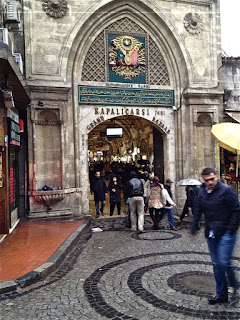The Grand Bazaar opened in 1461 and contains over 4,000 shops. There are 22 entrances, which is not enough when you're trying to find your way out. Fortunately I had a GPS Istanbul app on my iPhone. When we started trying to find our way out, we ended up on the opposite corner that we needed to be on to get back to our hotel. The only way we knew that was by checking our location with GPS on the iPhone Istanbul app. Inside we asked a policeman for directions to the Blue Mosque. He pointed and said "Exit 5, then left." Exit 5 was farther away than I thought it would be, but we eventually got there and headed toward the Best Point Hotel to meet Jay for dinner.
There are 58 "streets" in the Grand Bazaar. And lots or ornate decoration.
A salesman asks us "What are you looking for?" I say "Nothing." He says "What do you want?" I say "Photographs."
Hmm. Were we here a few minutes ago?
One of the many Grand Bazaar entrances.
Looking for a way out, we run into a dead end courtyard.
Going back the other way, back into the Bazaar.
Jay (right) steps outside for a cigarette break at Gallista Cafe, just one block from our hotel. Excellent food and a great farewell visit with Jay.
Grab a few photos before we go outside to hail a taxi for Jay's trip back to Taksim.

Packed and waiting for our 5 am airport car, enjoying one last view of the Blue Mosque. Sadly, we'll miss tomorrow morning's call to prayer because we leave so early for the airport. Maybe not tooo sadly.




























